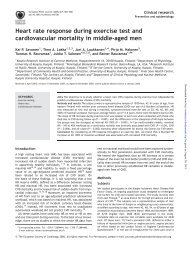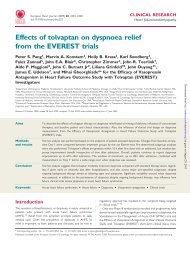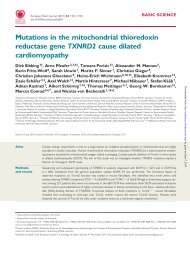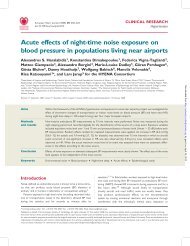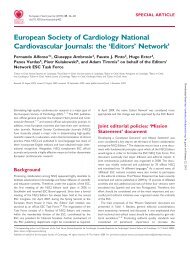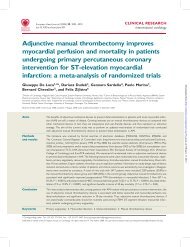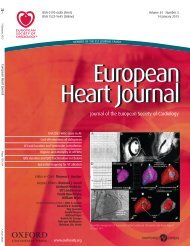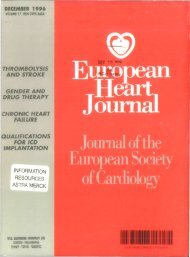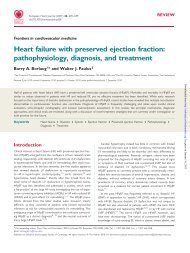Diagnosis of arrhythmogenic right ventricular cardiomyopathy ...
Diagnosis of arrhythmogenic right ventricular cardiomyopathy ...
Diagnosis of arrhythmogenic right ventricular cardiomyopathy ...
You also want an ePaper? Increase the reach of your titles
YUMPU automatically turns print PDFs into web optimized ePapers that Google loves.
810<br />
ARVC/D in a first-degree relative, the diagnosis <strong>of</strong> familial ARVC/D<br />
is based on the documentation <strong>of</strong> one <strong>of</strong> the following in a family<br />
member:<br />
(1) T-wave inversion in <strong>right</strong> precordial leads V1, V2, and V3 in<br />
individuals over the age <strong>of</strong> 14 years.<br />
(2) Late potentials by signal-averaged ECG (SAECG).<br />
(3) Ventricular tachycardia <strong>of</strong> left bundle-branch block morphology<br />
on ECG, Holter monitor, or during exercise testing<br />
or .200 premature <strong>ventricular</strong> contractions in 24 hours.<br />
(4) Either mild global dilatation or reduction in RV ejection fraction<br />
with normal LV or mild segmental dilatation <strong>of</strong> the RV<br />
or regional RV hypokinesis.<br />
Revision <strong>of</strong> the diagnostic criteria is important to provide guidance<br />
on the role <strong>of</strong> emerging diagnostic modalities and to recognize<br />
advances in the genetics <strong>of</strong> ARVC/D. The criteria have been modified<br />
to incorporate new knowledge and technology to improve<br />
diagnostic sensitivity, but with the important requisite <strong>of</strong> maintaining<br />
diagnostic specificity, and they include quantitative parameters<br />
for Task Force criteria, particularly for the imaging studies<br />
(Table 1). The approach <strong>of</strong> classifying structural, histological,<br />
ECG, arrhythmic, and genetic features <strong>of</strong> the disease as major<br />
and minor criteria has been maintained.<br />
Methods<br />
A limitation <strong>of</strong> the previous Task Force criteria was the reliance on<br />
subjective criteria for assessing <strong>ventricular</strong> structure and function<br />
and for evaluation <strong>of</strong> myocardial histology. In this modification <strong>of</strong><br />
the Task Force criteria, quantitative criteria are proposed and<br />
abnormalities are defined on the basis <strong>of</strong> comparison with<br />
normal subject data (Table 1). The data from 108 probands with<br />
newly diagnosed ARVC/D, age 12 years, who were enrolled in<br />
the National Institutes <strong>of</strong> Health-supported Multidisciplinary<br />
Study <strong>of</strong> Right Ventricular Dysplasia, 43 were compared with<br />
those <strong>of</strong> normal subjects (online-only Data Supplement). The criteria<br />
were selected on the basis <strong>of</strong> analysis <strong>of</strong> sensitivity and specificity<br />
from receiver operating characteristic curves. For analysis <strong>of</strong><br />
each test [e.g. echocardiogram, magnetic resonance imaging<br />
(MRI)], proband data were excluded if that test was crucial for<br />
the diagnosis <strong>of</strong> the individual patient. This was done to eliminate<br />
bias in estimating the sensitivity and specificity <strong>of</strong> that particular<br />
test. In general, when determining the sensitivity and specificity<br />
<strong>of</strong> a new screening test, it is recommended that none <strong>of</strong> the<br />
screening test elements be used in making the primary diagnosis;<br />
this principle also holds when establishing diagnostic criteria.<br />
Results<br />
There were 44 proband MRIs compared with 462 MRIs <strong>of</strong> normal<br />
subjects, 69 proband echocardiograms compared with 450 echocardiograms<br />
<strong>of</strong> normal subjects, 69 proband SAECGs compared<br />
with 103 SAECGs <strong>of</strong> normal subjects, and 68 proband Holters<br />
compared with 398 Holters <strong>of</strong> normal subjects. The minor criteria<br />
for echocardiography were selected where specificity and sensitivity<br />
are equal (sensitivity equals specificity) (Table 2). The major<br />
criteria were selected as the value that yielded 95% specificity. Sensitivity<br />
and specificity for the MRI criteria were made<br />
independently for each sex and with consideration <strong>of</strong> both the<br />
RV end-diastolic volume indexed to body surface area (size) and<br />
RV ejection fraction (function) simultaneously by using the OR<br />
logistical function. If either RV size or function was positive in conjunction<br />
with RV wall motion abnormality, then the subject would<br />
be classified as having a major criterion for the MRI. The sensitivity<br />
<strong>of</strong> RV size alone or function alone ranged from 41% to 50% for<br />
major criteria and 31% to 41% for minor criteria, with specificity<br />
<strong>of</strong> 96% to 100%. Using the OR logistical function improved the<br />
sensitivity <strong>of</strong> the MRI to 79% to 89% for major criteria and 68%<br />
to 78% for minor criteria.<br />
The original Task Force criteria list late potentials as a minor criterion.<br />
It has become common practice, though not based on evidence,<br />
to state that the SAECG is positive if 2 <strong>of</strong> the following 3<br />
parameters are abnormal: filtered QRS duration (fQRS), rootmean<br />
square voltage <strong>of</strong> the terminal 40 ms <strong>of</strong> the QRS, or duration<br />
<strong>of</strong> the terminal QRS signal ,40 mV. Analysis <strong>of</strong> each <strong>of</strong> the single<br />
parameters <strong>of</strong> the SAECG with late potentials by using a 40- to<br />
250-Hz filter had a sensitivity ranging from 58% to 60%, with a<br />
specificity <strong>of</strong> 94% to 96%. Two <strong>of</strong> three parameters had a sensitivity<br />
<strong>of</strong> 66% and specificity <strong>of</strong> 95%, adding little advantage with<br />
regard to sensitivity and specificity. Using any one <strong>of</strong> the 3<br />
SAECG parameters had a sensitivity <strong>of</strong> 74% and specificity <strong>of</strong> 92%.<br />
A definitive diagnosis <strong>of</strong> ARVC/D is based on histological demonstration<br />
<strong>of</strong> transmural fibr<strong>of</strong>atty replacement <strong>of</strong> RV myocardium<br />
at biopsy (Figure 2), necropsy, or surgery. 5,44 In most patients,<br />
however, assessment <strong>of</strong> transmural myocardium is not possible.<br />
In addition, diagnosis based on RV endomyocardial biopsy specimens<br />
is limited because the segmental nature <strong>of</strong> the disease<br />
causes false negatives. Use <strong>of</strong> electroanatomic voltage mapping<br />
to identify pathological areas for biopsy sampling may improve<br />
the yield. 45 RV free wall biopsy has a slight risk <strong>of</strong> perforation,<br />
but the more accessible inter<strong>ventricular</strong> septum rarely exhibits histological<br />
changes. Nevertheless, endomyocardial biopsy may identify<br />
other conditions (e.g. myocarditis, sarcoidosis, endomyocardial<br />
fibrosis), and the recognition <strong>of</strong> myocyte loss with fibrous or fibr<strong>of</strong>atty<br />
replacement can be a valuable diagnostic feature. 46<br />
The identification <strong>of</strong> disease-causing genes has led to the<br />
recognition <strong>of</strong> a broader spectrum <strong>of</strong> disease expression within<br />
families, including individuals who have predominantly LV disease,<br />
manifest clinically by inferolateral T-wave changes, <strong>ventricular</strong><br />
ectopy, or <strong>ventricular</strong> tachycardia with <strong>right</strong> bundle-branch block<br />
morphology and epicardial or midmyocardial late enhancement<br />
by MRI. 4,7,38,39,41 The importance <strong>of</strong> familial disease highlights a<br />
role for mutation analysis <strong>of</strong> probands with cascade screening <strong>of</strong><br />
relatives that <strong>of</strong>fers an alternative strategy to serial noninvasive cardiovascular<br />
evaluation <strong>of</strong> families. A positive diagnosis in a family<br />
member changes the probability <strong>of</strong> disease in an individual suspected<br />
<strong>of</strong> the disease to 1:2 from 1:1000 to 1:5000. Thus, confirmed<br />
disease in a first degree relative is a major criterion for<br />
diagnosis. 42<br />
Discussion<br />
F. I. Marcus et al.<br />
The diagnosis <strong>of</strong> ARVC/D relies on the demonstration <strong>of</strong> structural,<br />
functional, and electrophysiological abnormalities that are<br />
caused by or reflect the underlying histological changes. Technical<br />
advances in MRI and 2-dimensional echocardiography have<br />
Downloaded from<br />
http://eurheartj.oxfordjournals.org/ by guest on July 22, 2013



